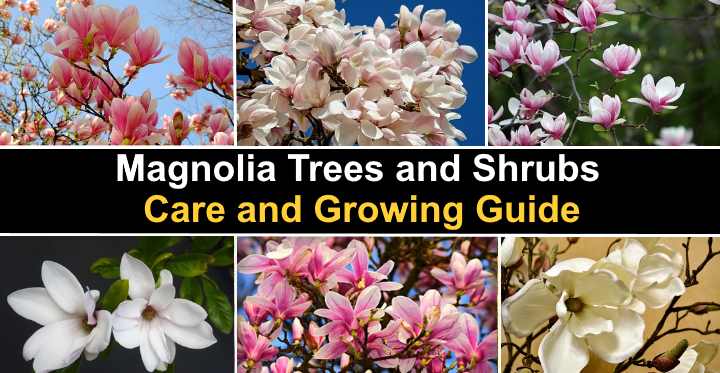Magnolia is a genus of flowering trees and shrubs that produce stunning white and pink bowl- or star-shaped flowers. Magnolia trees and shrubs are identified by their glossy, leathery leaves, fragrant, showy flowers, and cone-like fruits in the fall. Magnolias are easy to care for, and growing these trees or shrubby plants add beauty to garden landscapes.
Magnolia species belong to the Magnoliaceae family and there are around 210 of them. Magnolias may be either evergreen or deciduous trees, depending on the plant species. With a spread of 50 ft. (15 m), some magnolia trees can grow to be as tall as 90 ft. (25 m).
Magnolia bushes are large, multi-stemmed bushy plants that may grow up to 15 feet (4.5 meters) tall. The saucer magnolia (Magnolia x soulangeana) and the shrubby star magnolia (Magnolia stellata) are two popular magnolia types for gardens and backyard landscapes. You’ll learn more about different amazing types of magnolias at the end of this article. Growing magnolia trees and shrubs is covered in this article from beginning to end.
Magnolia Tree Care
Grow magnolia in well-draining soil and keep the area moist to care for it. Full sun or partial shade is ideal for Magnolia trees and shrubs. When the buds start to swell in the spring, fertilize the garden plant. To improve the magnolia’s appearance, prune it after blooming.
Magnolia Flowers
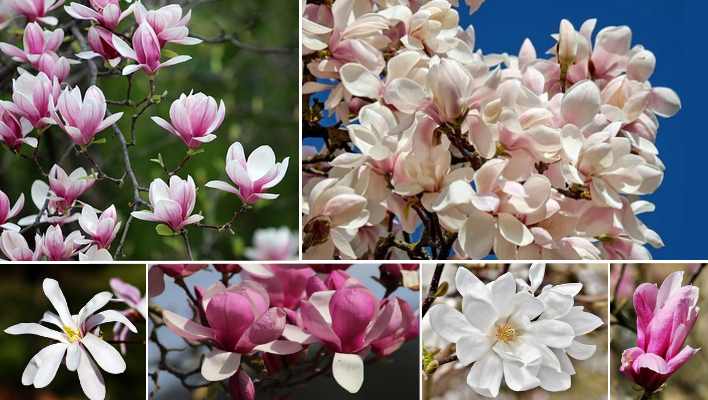
Magnolia flowers, which bloom in the spring, are normally white or hues of pink. The lovely flowers are generally star or bowl-shaped. The petals may be long and strap-shaped or wide with a pointed tip. The huge, gorgeous blossoms measure 8 to 12 inches (20 to 30 cm) across.
The fragrance of big magnolia blossoms is also a striking characteristic. Sweet scents reminiscent of honey, sweet candy, or citrus are emitted by the fragrant pink or white flowers. When they bloom in early to mid-spring, these beautiful fragrances fill backyards.
How to Choose the Best Type of Magnolia
Most circumstances are suitable for growing magnolia varieties. Though magnolias are popular flowering tree and shrubs in the South, certain hardy kinds are suitable for northern yards. Some types bloom in the fall and winter, whereas most types bloom in the spring. When selecting the finest magnolia for your yard, there are a few things to consider:
- Landscape use—Magnolias may be big shade trees, evergreen blossoming hedge plants, specimen lawn trees, or bushy container shrubs.
- Light—Magnolias prefer full sun to partial shade, and most species require both.
- Size of the garden—Inspect the tree or shrub’s mature height. Magnolias may grow to be enormous trees with a wide canopy. Minimal shrubs or single-stemmed trees are available for tiny to medium-sized gardens as cultivars.
- Climate—In the USDA zone where you live, check if the magnolia is cold hardy. Most climates can be grown with magnolia cultivars.
- Color—Remember to take into account the flower’s color. Magnolia bushes and trees bloom in lavender, purple, pink, and yellow blooms, despite the fact that most magnolia blossoms are snow-white.
Where to Buy a Magnolia?
At local garden centers, home improvement shops, and online stores, you may get young magnolia trees to plant. Pick a magnolia that has space to develop in your yard and is appropriate for the area when determining the greatest shrub or tree for your front or backyard.
How to Care for Magnolia Trees and Shrubs
To enhance the aesthetics of your garden landscape, let’s take a closer look at how to grow a magnolia.
Where to Plant a Magnolia

Plant a magnolia tree or shrub in your garden, but keep it out of the scorching midday sun. Magnolias may tolerate some shade, despite their preference for full sun. A spot with cover from the heat midday and afternoon sun is preferred if you reside in hot areas.
Magnolias should be grown in a location that is protected from the wind and has good sunlight. The branches may break and the big flowers may be damaged by strong breezes and windy conditions.
The Best Soil for Growing a Magnolia
Magnolias prefer damp but drainable soil. Magnolias are drought-tolerant plants that have been grown for a long time. The positive aspect is that most magnolia species can grow in a variety of soil conditions. Clay, sandy, loamy, and poor-quality soils will therefore support the growth of plants.
The pH level of the soil should be neutral for optimal development. If the soil is somewhat acidic or alkaline, magnolias will flourish. Check that the soil isn’t too alkaline if magnolia leaves start to yellow for no reason.
What Time of Year to Plant a Magnolia?
Evergreen magnolias should be planted in the spring. The quick establishment of the root system will be aided by the warm spring weather in Southern states. After planting in the spring, water the juvenile magnolia tree. In colder, temperate climates, plant deciduous magnolia trees in the early fall.
The roots will have time to establish themselves even if growth is slow in the winter. The magnolia will be ready to bloom with pink or white blossoms by the time warmer weather arrives in the spring.
How to Plant a Magnolia

Take into account elements such as sunlight, soil drainage, and enough space when planting magnolia trees or shrubs. The tree should be planted in a spot with plenty of sunlight and good drainage. Lastly, make sure that the crown has enough room to expand. And don’t forget about the deep root system, so avoid planting near your property.
Here’s how to plant a magnolia:
To reveal the top root of the magnolia, remove the top layer of soil from around it. This permits you to put the young magnolia tree in the same spot it was in when it was growing. Dig a hole that is 1.5 times the size of the magnolia tree’s root ball, but not as deep.
Make sure the exposed upper root points in line with the soil’s surface when you put the young magnolia tree into the hole. Next, to make the tree stable, fill the remaining area with organic-rich soil and firm it down to eliminate air pockets.
Give the freshly planted magnolia a good watering. Next, lay a 2-inch (5-cm) layer of mulch around the tree, leaving a 1 inch (2.5 cm) clearance all around the trunk. When it breaks down, organic mulch retains moisture while providing nutrients. This method prevents your new magnolia tree from needing fertilizer.
How to Water a Magnolia
During the growing season, water was applied to weekly maintain magnolia trees. For each inch (2.5 cm) of trunk diameter, you should apply two to three gallons (7.5 – 11 l) of water every week as a rule. watering young magnolia trees is more important. Water the small tree twice a week in temperate climates and three times a week in warm climates after planting it.
To help the plant establish itself, continue watering it on a six-month schedule. During the growing season, you may lower watering to once per week.
How to Grow Magnolia in Pots
The best container plant choices are small magnolia bushes or dwarf trees. At least twice the size of the root ball, a pot is required. To improve drainage, choose an organic-rich potting soil and add coarse sand. In the pot, place the magnolia shrub so that it is at the same level as the potting mixture. Leave a 2 inch (5 cm) gap at the top of the container to put a layer of mulch on.
For the first few months, water the new magnolia plant twice a week to keep the soil moist without being soggy. Reduce watering the shrub to once a week during the growing season once the magnolia is established. Remembering to use a strong container with a drainage hole is crucial. Magnolias may quickly outgrow their pots and grow into large shrubs or tiny trees.
How to Prune a Magnolia Tree

Magnolia trees and bushes may be pruned to encourage more blooming. Pruning multi-stemmed plants may help them become specimen trees by forcing them to grow upright. Regular pruning also encourages more flowers. Magnolia pruning time is determined by the climate and variety of tree.
Prune evergreen magnolias If it’s necessary, I’ll do it in late spring. Shortening the newer, longer branches and removing the lower limbs of the main stem are two surefire ways to prune the shrub.
Prune deciduous magnolias Late summer or early fall is the best time to plant.
It’s important to keep in mind, though, that pruning young evergreen or deciduous magnolias is not always required and may cause the plant to be overstressed.
Fertilizing a Magnolia Tree or Shrub
To promote blooming and healthy development, fertilize magnolias every year with a high-nitrogen, slow-release fertilizer. Three times more nitrogen than phosphorus is required for optimum magnolia fertilizer. NPK ratings of 12-4-8 or 20-5-10 are good signs that a fertilizer is right for you. The ideal moment to fertilize magnolia trees varies depending on the variety.
Fertilize deciduous magnolias Once the leaves have fallen in the late autumn.
Fertilize evergreen magnolias Around a month before the temperature is expected to drop below 40°F (4°C), it begins to fall. In the spring before any new growth on the evergreen or deciduous branches, you can also fertilize all types of magnolia trees and shrubs.
Propagating a Magnolia Tree from Seeds
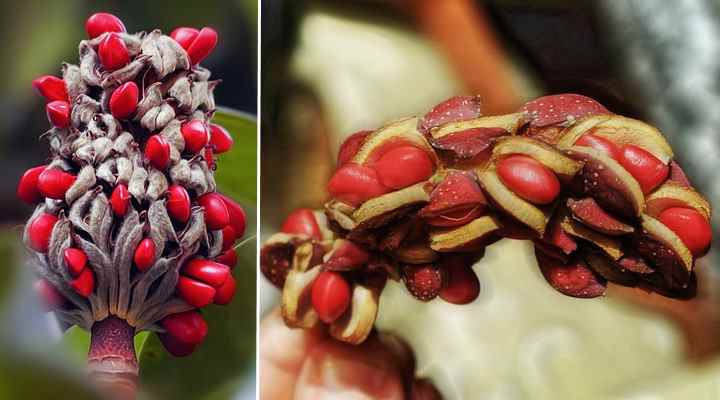
The bright red berries that appear in the autumn contain Magnolia seeds. Seeds from magnolia trees frequently root in the soil beside the tree after they fall. Magnolia trees may also be propagated by seed. Growing magnolias from seed, on the other hand, is a long and sometimes failed process.
Diseases Affecting Magnolia Tree and Shrub Growth
Magnolia trees and plants are non-disease prone hardy landscape plants. Leaf spot can be caused by fungal or bacterial diseases. Another kind of ailment that may afflict stressed magnolias is tree canker. The majority of magnolia tree diseases are relatively benign and only affect the appearance of the tree.
Magnolia Care – FAQs
While magnolia trees are typically easy to maintain, they may face a few difficulties in development. Solutions to some magnolia-growing issues are listed below.
Why are magnolia leaves turning yellow?
The natural growth cycle of yellow leaves on magnolia trees may include some. Before falling, older leaves become yellow. You don’t need to be concerned if there’s fresh leaf growth in their stead. Watering problems, sun damage, and incorrect pH levels in the soil are among the other reasons a magnolia tree may appear to be dying.
If the roots are under strain or drowning, too much or insufficient water may make magnolia leaves yellow. Always make sure the dirt is neither too dry nor soggy, but rather just moist. Use a pH tester to test for acidity if you believe that soil quality is to blame. The soil that magnolias prefer is neutral to slightly acidic. You may need to adjust the soil if pH levels are too high or low.
Why are magnolia flower buds not opening?
Magnolia buds don’t open because there isn’t enough sunlight and the nitrogen is issues. The buds may appear but fail to open if the magnolia shrub or tree is in too much shade. Buds can also stay closed instead of opening if there is too much nitrogen in the soil. Frost can also affect maagolia buds. The buds won’t open if you experience a late-spring frost, and they’ll fall from the tree instead.
If your magnolia tree has a thrip problem, it may also cause buds to stay closed. Thrips may be detected on the tree leaves, and the sap-sucking creatures may be rid of using a neem oil solution.
Why doesn’t my magnolia tree flower?
If the weather is too cold, Magnolia trees may fail to bloom. Cold weather affects magnolias. An unseasonal cold snap may impact magnolia blooming habits, even if the trees are growing in the appropriate zone. The tree will then fail to flower. Too little sunlight or growing in alkaline soil are additional reasons why magnolias don’t bloom.
How fast do magnolia trees grow?
Slow to medium growth is typical of Magnolia plants. Only if growing conditions are ideal will a magnolia tree or shrub grow between 1 and 2 feet (30 and 60 cm) each year. Magnolias develop a huge, spreading shade canopy that may cover the shrub or tree itself if it is tall over time.
My magnolia tree leaves have black spots, what should I do?
Pest damage or disease may cause dark spots on magnolia tree leaves. Bacterial or fungal infections could cause black or dark brown leaf spots. The incidence of these disorders increases in humid or rainy weather. To eliminate the problem, try trimming the branches to reduce foliage and increase air flow.
Be careful of invasive magnolia roots
Don’t plant a magnolia too close to your home when selecting where to place one. The Southern Magnolia (Magnolia grandiflora) has a root system that can spread up to 40 feet (12 meters) from the tree trunk. The root system of amellolias is shallow. If planted too close to buildings, they may damage foundations and water pipes.
Types of Magnolia
Southern Magnolia (Magnolia grandiflora) – In zones 7 through 9, the gorgeous Southern Magnolia is evergreen. This plant has huge white blossoms that grow up to 8 inches (20 cm) across and grows between 60 and 80 feet (18 – 24 meters) tall.
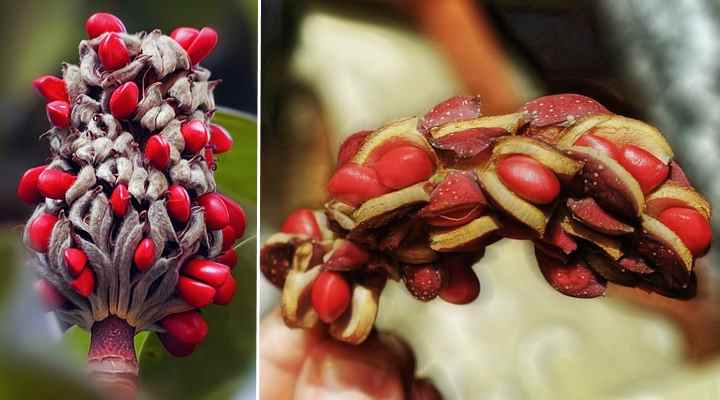
Saucer Magnolia (Magnolia x soulangeana) – One of the most popular landscaping plants is this deciduous magnolia variety. Pink, fragrant, bowl-shaped blooms up to 10 inches (25 cm) across are produced by this huge shrub or tree.
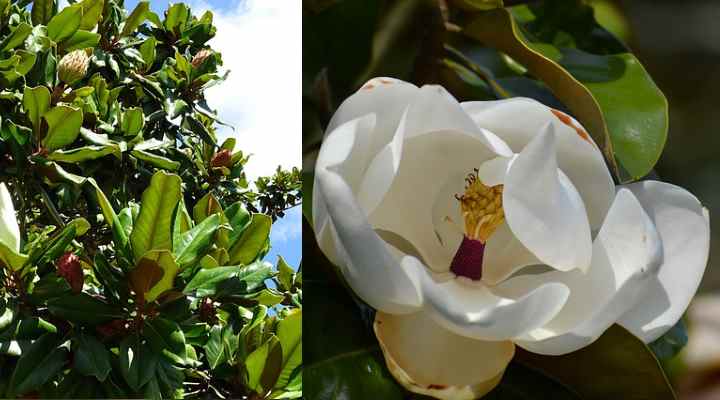
Magnolia x loebneri – With a similar spread, this dwarf magnolia tree grows between 8 and 15 feet (2 and 5 meters). Long, slender petals with streaks of light pink characterize the white fragrant, star-shaped blooms.

Black Lily Magnolia (Magnolia liliiflora) — The Black Lily magnolia plant has thick, green leaves and a rounded crown. The dark pink tulip-like blooms are 5 inches (12 cm) long when fully open.
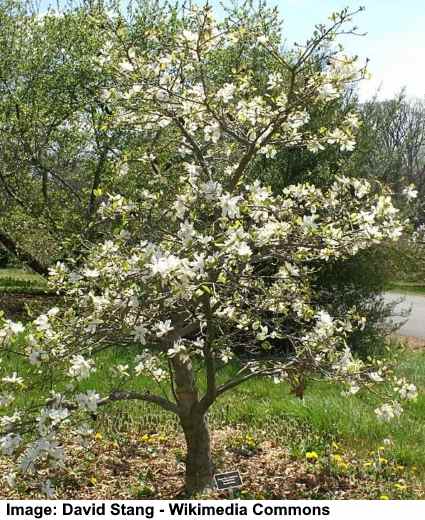
Pink Stardust Magnolia (Magnolia stellata ‘Pink Stardust’) — Little gardens and container plants are ideal for this tiny magnolia shrub. To brighten a spring garden, the shrub blooms with white and pink flowers.

Pink Stardust Magnolia
